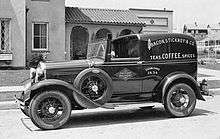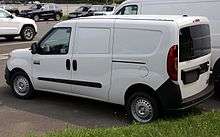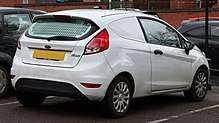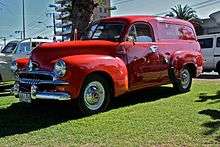Panel van
A panel van — also known as a blind van, car-derived van (United Kingdom) or sedan delivery (United States) — is a cargo vehicle based upon passenger car chassis, and typically has one row of seats with no side windows at the rear.[1] Panel vans are smaller than panel trucks and cargo vans, both of which are built on a truck chassis.
_van_(24101619705).jpg)
.jpg)
As it is derived from their car chassis, its evolution of the design is also intermingled with it as well, with much of its evolution dependent upon the various international locations where a particular model's found. North American panel vans were initially based upon the 2-door station wagon models.[2][3] In Europe, where many cities have histories (and roads) hundreds of years'-long, necessitated that panel vans were (and still are) typically smaller than those elsewhere, and are built on either a bespoke chassis or the chassis of a subcompact car. In Australia, panel vans were a development of the ute (a small pickup truck based on a passenger car chassis, e.g. Chevrolet El Camino), often using the longer wheelbase of the station wagon chassis.
Origins

It is not known when the first panel van entered production, however it became an established type of vehicle by the end of the 1920s.[4]
The panel van body style has experienced separate evolutions in America, Europe and Australia, as a result of the separate evolutions of the passenger car platforms (upon which the panel van is based) in each region.
North America



A panel van is often known as a delivery in North America. It's an older term that usually only applies to station wagon-based vehicles (sedan deliveries/delivery wagons) such as the Chevrolet Delray and Ford Courier,[5] or pickup-based vans (panel deliveries).[6] Large, boxy unibody vans based on truck platforms (such as the Ford Transit,[7] Ram ProMaster,[8] and Chevrolet Express[9]) as well as smaller unibody vans (like the Ford Transit Connect[10] and Ram Promaster City[11]) are usually referred to as cargo vans or just panel vans. Larger vehicles built on a chassis cab with a custom cargo box are usually called box trucks or moving vans.
In the late 1920s, Ford produced "Town Car Delivery" and "Wood Panel Delivery" as part of the Ford Model A model range.[12] Later Plymouth produced a sedan delivery from 1935 until 1941.[13] Pontiac produced deliveries until 1953 in the U.S. and until 1958 in Canada based on the Pontiac Pathfinder.[14] Sedan delivery models were usually produced in small quantities of 200 or less, for example 449 Canadian Pontiac sedan deliveries were built in 1958.
From 1959 on, the sedan delivery was no longer practical; it was phased out in 1960 as a Chevrolet model, so the requisite Chevrolet body was no longer available.[15] With the growing sales of the Volkswagen Type 2 and the introduction of compact vans, sedan deliveries faded from the scene. Chevrolet dropped the body type after 1960, while Ford moved it to the Falcon line-up until 1965.[16]
In the 1970s, Chevrolet and Ford offered subcompact sedan deliveries with the Chevrolet Vega Panel Express and the Ford Pinto Panel Wagon. The Vega Panel Express was introduced in September 1970 and it was Chevy's first sedan delivery in ten years since the final full-size model was offered in 1960.[17] The Vega Panel Express body style accounted for less than 2% of the total Chevrolet Vegas produced during the 1971 through 1975 model years.[16] First year sales of the Vega Panel Express peaked at 7,800 units and after leveling off to 4,000 units per year, only 1,525 were sold in 1975.[18] The Pontiac Astre Panel, Pontiac's version of the Vega Panel Express, was available in Canada in the 1973–75 model years and in the US for 1975.[14] The Pinto Panel Wagon was introduced in 1976 and was offered in both a commercial and a "factory customized" Pinto Cruising Wagon version that featured a round porthole style window on each side.[16] The Ford Courier name, previously used for Ford sedan delivery vans, began to be used with Ford's import pickup truck line.[19]
In 2002, Chrysler showed a concept car edition of a panel van based on the PT Cruiser at the North American International Auto Show, but it was not manufactured. In 2007 Chevrolet released a panel van version of the HHR, marketed as the HHR Panel.[20]
The small cargo vans currently sold by American manufacturers are from their overseas divisions, for example the Ford Transit Connect and Dodge Ram ProMaster City.
Europe
.jpg)
_van_(2017-01-30)_02.jpg)

European panel vans of the 20th century include the Citroën 2CV Fourgonnette, Citroën H Van, Citroën C15, Ford Escort, Morris Minor, Renault Estafette, SEAT Inca[21] and more recently the Renault Kangoo and the Opel Combo.[22]
From the 1950s onwards, a larger alternative to the panel van was the van (based on a commercial vehicle chassis instead of a passenger car chassis), such as the Volkswagen Type 2, the DKW van and the first-generation Ford Transit in 1965.[23][24][25]
In the United Kingdom, panel vans benefit from having lower taxes than station wagons[26] and do not have the speed restrictions which apply to larger vans.[27] This has given rise to some anomalies. Authorities and dealers are not always certain on what qualifies as a car-derived van.[28]
Examples of panel vans from the last 30 years are the Renault Kangoo (1997), the Fiat Doblò (2001), Opel Combo (2001), Ford Transit Connect (2002) or the Volkswagen Caddy (2004). They are also purpose-designed to be utilitarian base model MPVs / people carriers, for a range of such vehicles. In 2018, Ford Europe introduced a van configuration of the Ford Fiesta, sharing its body with the regular passenger version.[29]
As of 2019, the market consists of the following models and many more:
Australia
.jpg)

.jpg)
.jpg)
_Longreach_GLi_Tradesman_1_Tonne_panel_van_(2015-06-18)_02.jpg)
The first Holden panel van produced in Australia was the FJ Holden, which was released in December 1953,[30] although many manufacturers offered panel vans in their range prior to this.[31][32][33][34][35][36][37][38] As per many Australian panel vans, it was based on the ute model, with additional body work at the rear. In May 1961, Ford Australia released a panel van version of the XK Falcon, marketed as the "sedan delivery" body style.[39] The first panel van by Chrysler Valiant was part of the CL Valiant model range and was introduced in April 1977.[40]
Painters, electricians, general labourers and film crews[41] would often use panel vans, due to the extra cargo area and customisable interior in a relatively compact vehicle. Australian police forces also used panel vans as police vans (nicknamed "divvy vans" or "paddywagons").[42]
Early Australian panel vans used swing-down and -up tailgates and a standard roof height, due to their origins of the ute body style. Some later models offered horizontally opening rear doors (nicknamed "barn doors") and a higher roofline for increased cargo area.
By the early 1970s, at a time when the American panelvan was in decline, panel vans had become Australian cultural icons.[43] The most popular model was the Holden Sandman, which was marketed towards young men, in particular targeting the surfing lifestyle.[44][45] The first Sandman was built in small numbers in 1974 for the HQ model range, however the model's popularity greatly increased with the following HJ generation, which was released in October 1974.[46][47] In the 1979 movie Mad Max, a modified 1975 HJ Sandman model appeared as one of the vehicles driven by the lead character (played by Mel Gibson).[48]
Ford's equivalent of the Sandman was the Surferoo model, which was introduced into the XB Falcon model range in 1973, which was not a successful model.[49][50] The Surfaroo was replaced by the more popular Sundowner model, which was introduced into the XC Falcon range in 1977.[46][44] In 1976, Chrysler released a similar model called the Drifter, which was part of the Chrysler CL Valiant. The Drifter was not a success and ceased production in 1978.
Younger drivers were especially attracted to panel vans, for reasons such as the ease with which a mattress could be installed within the cargo bay. Consequently, panel vans also attracted nicknames such as "sin bins," and "shaggin' wagons".[51] This kind of activity was frequently carried out at the local drive-in theatre.[52] During the 1970s it also became fashionable to decorate the exterior sides with murals, often painted with intricate detail.[53] Along with the Volkswagen Kombi, panel vans were very popular with surfers, as it was convenient to sleep in the cargo bay while carrying surfboards on the roof.
By the end of 1979, the Sandman had largely lost its place in the contemporary Australian youth culture – order figures were down and many of the vehicles were now being sold with the stripes and tailgate logos deleted. The final Sandman model was during the Holden HZ series and featured a choice of V8 engines only, along with a four-headlight grille and under bumper front spoiler. According to a GMH Price List dated 25 January 1979, a basic HZ Holden panel van was priced at A$6,076, with the Sandman option package an additional A$1,700. If a buyer selected every Sandman extra, which would cost in excess of 50% more than a basic HZ panel van, Holden would include a velvet mattress with Holden logo embroidered. The Sandman ute was phased out in October 1979, followed by the Sandman panel van prior to the end of the HZ series.[54]
Panel vans in general were declining in popularity during the 1980s. Holden's last panel van was the WB model, which ceased production in 1984.[55] Subsequently, Ford became the sole manufacturer of them until 1999 when production of last entry in the history of the Australian panel van, the XH Falcon, ceased.
In 2000, Holden unveiled a Sandman show car based on their Holden VU Ute of the time. This Sandman was never released, however from 2003 to 2005 an optional canopy in the same style was sold as panel vans,[56] however they still retained the rear window and firewall of the ute they were originally based on, preventing movement between the cargo bay and the passenger cab, as offered by traditional panel vans.
See also
- Car body style
- Light commercial vehicle
- Panel truck, built on a truck chassis, a panel truck is usually larger than a panel van
- Pickup truck
References
- "Car-derived vans and dual purpose vehicles – GOV.UK". GOV.UK. Retrieved 18 February 2018.
- "Another look at sedan deliveries". Mac's Motor City Garage. 12 September 2013. Retrieved 18 February 2018.
- Adams, Keith (25 September 2011). "Commercials : Car derived vans/pick-ups – AROnline". AROnline. Retrieved 18 February 2018.
- "What is a Panel Van?". www.wisegeek.com. Retrieved 18 June 2018.
- https://www.flickr.com/photos/autohistorian/3761321826
- https://www.flickr.com/photos/autohistorian/16133236350
- https://www.ford.com/commercial-trucks/transit-cargo-van/?gnav=header-all-vehicles
- https://www.ramtrucks.com/ram-promaster.html
- https://www.chevrolet.com/commercial/express-cargo-van
- https://www.ford.com/commercial-trucks/transit-connect-cargo-van/?gnav=header-all-vehicles
- https://www.ramtrucks.com/ram-promaster-city.html
- "Putting on the Ritz – The Model A Ford Town Car Sedan Delivery | The Old Motor". theoldmotor.com. 31 July 2014. Retrieved 18 February 2018.
- Benjaminson., Jim. "Plymouth vans and delivery trucks". allpar.com. Retrieved 18 February 2018.
- Jewell, Alden (25 November 2014). "The Sedan Delivery". aldenjewell.com. Retrieved 18 February 2018.
- 1960–61 Chevrolet Full-Line Truck brochures
- Halter, Tom (9 July 2017). "Automotive History: The Sedan Delivery". curbsideclassic.com. Retrieved 18 February 2018.
- "1971–1975 Chevrolet Vega Panel Express and the 1973–1975 Pontiac Astre Panel". www.oldcarscanada.com. 13 June 2015. Retrieved 9 March 2018.
- h-body.org
- Martin, Murilee (3 November 2011). "Junkyard Find: 1972 Ford Courier". The Truth About Cars. Retrieved 9 March 2018.
- Nunez, Alex (6 October 2006). "Chevy introduces HHR Panel". Autoblog. Retrieved 9 March 2018.
- Dutch, Johannes (24 July 2015). "CC Global: Compact European Panel Vans – Their Evolution in the Past 25 Years". curbsideclassic.com. Curbside Classic. Retrieved 4 March 2018.
- Axon, Gary (2 March 2018). "Axon's Automotive Anorak: Attack of the vans". goodwood.com. Retrieved 4 March 2018.
- Turla, Antanas (13 June 2017). "VW Type 2 – The Most Important Van in the History?". DriveTribe. Retrieved 4 March 2018.
- Niedermeyer, Paul (29 March 2010). "The Mother Of All Modern Minivans: 1949 DKW Schnellaster – The Truth About Cars". The Truth About Cars. The Truth About Cars. Retrieved 4 March 2018.
- Moss, Darren (30 July 2013). "History of the Ford Transit: picture special". autocar.co.uk. Autocar. Retrieved 4 March 2018.
- "What is a car, commercial vehicle or motor home for VAT". HM Revenue & Customs (HMRC).
- "Speed limits and speeding". direct.gov.uk.
- "Confusion over van speed limits". www.fleetnews.co.uk. 28 July 2005. Retrieved 4 March 2018.
- "It's the new Ford Fiesta Sport Van!". Top Gear, 24 April 2018.
- "Aussie Classic: 1951–1957 FX & FJ Holden Utes & Vans". www.truckjungle.com. Retrieved 24 October 2018.
- https://trove.nla.gov.au/newspaper/article/248559792
- https://trove.nla.gov.au/newspaper/article/117228097
- https://trove.nla.gov.au/newspaper/article/117198825
- https://trove.nla.gov.au/newspaper/article/244885752
- https://trove.nla.gov.au/newspaper/article/198235846
- https://trove.nla.gov.au/newspaper/article/169584951
- https://trove.nla.gov.au/newspaper/article/244599199
- https://trove.nla.gov.au/newspaper/article/243462300
- Bushby, A. C. (1989). The Australian Ford Falcon. ISBN 0-7316-3621-X.
- "Valiant CL Technical Specifications". www.uniquecarsandparts.com.au. Retrieved 24 October 2018.
- "Model FJ Holden panel van commemorates newsreel era at National Film and Sound Archive". www.abc.net.au. Retrieved 24 October 2018.
- "Aussie Panel Van: Ford Falcon XD Police Divvy Van". www.doogiesdiecast.wordpress.com. Retrieved 24 October 2018.
- Huynh, Mike (20 January 2015). "10 Most Iconic Australian Cars in Aussie Culture". D'MARGE. Retrieved 24 February 2018.
- "Holden Sandman turns 40". www.carsguide.com.au. Retrieved 25 October 2018.
- "Australian Vanning History- Part 1" (PDF). www.vanning.org.au. Retrieved 26 October 2018.
- "Holden Sandman review". www.tradeuniquecars.com.au. Retrieved 25 October 2018.
- "Welcome the new HJ; a fresh face". www.allaboutholdens.com. Retrieved 25 October 2018.
- "1979 "Mad Max"/ 1975 Holden Sandman HJ – Best Movie Cars". Best Movie Cars. 25 April 2017. Retrieved 24 February 2018.
- "History of the Ford Falcon XB". www.whichcar.com.au. Retrieved 25 October 2018.
- "Ford vs. Holden". www.e-motor.com.au. Retrieved 25 October 2018.
- Byrne, Bob (18 October 2014). "The Shaggin' Wagon – Cars From Our Youth". www.adelaiderememberwhen.com.au. Retrieved 24 February 2018.
- "Living in the 70's – Panel Vans". www.abc.net.au. Retrieved 24 October 2018.
- King, Poppy (12 April 2002). "Sex and art on wheels". www.theage.com.au. Retrieved 24 February 2018.
- "1977 to 1979 The HZ Series". www.allaboutholdens.com. Retrieved 26 October 2018.
- "1980 to 1984 The WB Series". www.allaboutholdens.com. Retrieved 26 October 2018.
- "History of the Sandman". www.rarespares.net.au. Retrieved 26 October 2018.